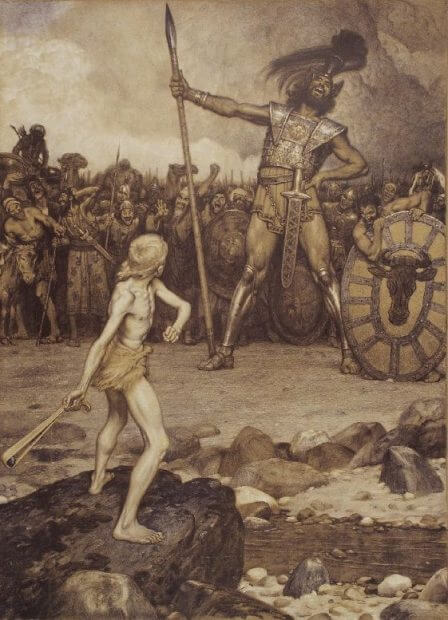Who are the Nephilim?
In the sixth chapter of Genesis, we’re confronted with a curious reference to the Nephilim. Who are they? Were they a race who came to be through the mingling of divine beings and the daughters of men? Were the Nephilim engineered by God’s enemies to thwart his plans for mankind?
Even more puzzling is how the Nephilim could show up in Numbers 13—long after the flood. Wouldn’t they have died out in the flood with the rest of humanity? How could they have shown up in Canaan? Is it possible that Noah himself was a Nephilim?!
In his book, The Unseen Realm: Recovering the Supernatural Worldview of the Bible, Dr. Michael S. Heiser (Ph.D. in Hebrew Bible and Semitic Languages at the University of Wisconsin-Madison) unpacks this controversial topic by looking at the passages where the Nephilim show up, exploring a few explanations for the Nephilim’s existence before—and after—the flood.
The following post is adapted from The Unseen Realm.
At war with the serpent’s offspring
In the third chapter of Genesis, God told Eve that her offspring would be locked in conflict with the serpent’s offspring (Gen 3:15). The serpent was actually a divine being, not a mere member of the animal kingdom. The divine being in the garden who rebelled against Yahweh’s desire to have humans rule an Edenic world is never cast in human form. Unlike the sons of God in Genesis 6:1–4 who are cast as assuming human flesh and capable of cohabitation, the divine rebel of Eden does not appear to Eve that way.
Consequently, the idea of a “seed” or offspring extending from the nachash (serpent) would not have been literal for the biblical writer. Instead, the notion is metaphorical or spiritual. And this is precisely what we see when the phrase occurs elsewhere in the Bible. The metaphor is perhaps most clear in the New Testament, when Jesus himself referred to the Pharisees as serpents (Matt. 23:33) who were “of [their] father the devil” (John 8:44; cf. Rev. 12:6).
Despite the metaphorical nature of the language in the Eden story, the idea of divine beings producing human spawn who would oppose Yahweh’s desires does appear in Genesis 6:1–4.
When man began to multiply on the face of the land and daughters were born to them, the sons of God saw that the daughters of man were attractive. And they took as their wives any they chose. Then the Lord said, “My Spirit shall not abide in man forever, for he is flesh: his days shall be 120 years.” The Nephilim were on the earth in those days, and also afterward, when the sons of God came in to the daughters of man and they bore children to them. These were the mighty men who were of old, the men of renown. (Gen 6:1–4)
The origin of the Nephilim
How are we to understand from Genesis 6:4 that the Nephilim were upon the earth at the time of the flood “and also afterward”? How do we process their original presence?
Any viewpoint that strips the account of its supernatural flavor must be discarded. The events described in Genesis 6:1–4 were part of Israel’s supernatural worldview. We cannot pretend they saw things as most modern readers would. Since the Nephilim were part of Israel’s supernatural worldview and their descendants turn out to be Israel’s primary obstacle for conquering the promised land, the conquest itself must also be understood in supernatural terms.
There are two possible approaches to the origin of the Nephilim in Genesis 6:1–4 that are consistent with the supernatural understanding of the sons of God in the Israelite worldview.
Are the Nephilim descendants of divine beings?
The first and most transparent explanation is that divine beings came to earth, assumed human flesh, cohabited with human women, and spawned unusual offspring known as Nephilim. Naturally, this view requires seeing the giant clans encountered in the conquest as physical descendants of the Nephilim (Num. 13:32–33).
The primary objection to this approach is the sexual component. The modern enlightened mind simply can’t tolerate it. Appeal is usually made to Matthew 22:23–33 in this regard, under the assumption that verse 30 teaches that angels cannot engage in sexual intercourse:
On that day Sadducees—who say there is no resurrection—came up to him and asked him, saying, “Teacher, Moses said if someone dies without having children, his brother is to marry his wife and father descendants for his brother. Now there were seven brothers with us. And the first died after getting married, and because he did not have descendants, he left his wife to his brother. So also the second and the third, up to the seventh. And last of all the woman died. In the resurrection, therefore, whose wife of the seven will she be? For they all had her as wife.”
But Jesus answered and said to them, “You are mistaken, because you do not know the scriptures or the power of God! For in the resurrection they neither marry nor are given in marriage, but are like angels of God in heaven. Now concerning the resurrection of the dead, have you not read what was spoken to you by God, who said, ‘I am the God of Abraham and the God of Isaac and the God of Jacob’? He is not the God of the dead, but of the living!” And when the crowds heard this, they were amazed at his teaching. (Matt 22:23–33)
Angels and sexual intercourse
The text does not say angels cannot have sexual intercourse; it says they don’t. The reason ought to be obvious. The context for the statement is the resurrection, which refers either broadly to the afterlife or, more precisely, to the final, renewed global Eden.
The point is clear in either option. In the spiritual world, the realm of divine beings, there is no need for procreation. Procreation is part of the embodied world and is necessary to maintain the physical population. In like manner, life in the perfected Edenic world also does not require maintaining the human species by having children—everyone has an immortal resurrection body. Consequently, there is no need for sex in the resurrection, just as there is no need for it in the nonhuman spiritual realm.
But Genesis 6 doesn’t have the spiritual realm or the final Edenic world as its context. The analogy breaks down completely. The passage in Matthew is therefore useless as a commentary on Genesis 6:1–4.
The modern struggle with the supernatural
Despite the flawed use of this gospel passage, Christians still balk at this interpretive option for Genesis 6:1–4. The ancient reader would have had no problem with it. But for moderns, it seems impossible that a divine being could assume human flesh and do what this passage describes.
The objection is odd, since this interpretation is less dramatic than the incarnation of Yahweh as Jesus Christ. How is the virgin birth of God as a man more acceptable? What isn’t mind-blowing about Jesus having both a divine and human nature fused together? For that matter, what doesn’t offend the modern scientific mind about God going through a woman’s birth canal and enduring life as a human, having to learn how to talk, walk, eat with a spoon, be potty trained, and go through puberty?
All these things are far more shocking than Genesis 6:1–4, and yet this is what Scripture explicitly affirms when it informs us that the second person of the Godhead became a man. God became a man from conception onward.
The truth is that Christians affirm the incarnation because they have to—it defines Christianity. Genesis 6:1–4 is set aside as peripheral. But belief in a personal God as the Bible describes means embracing the supernatural. For the Christian, the high point of the supernatural story of Scripture—its most dramatic and unthinkable expression—is the incarnation of God in Christ.
The appearance of divine beings in human form
The notion that the sons of God came to earth in fleshly form ought to be more palatable than the incarnation, since it is less supernaturally spectacular. There is no suggestion that any corporeal appearance of a divine being was accomplished through incarnation—becoming an actual human. All such instances are lesser than the incarnation. This particular supernatural approach to Genesis 6:1–4 derives from other passages that plainly have divine beings (angels) in embodied human form.
For example, Genesis 18–19 is quite clear that Yahweh himself and two other divine beings met with Abraham in physical flesh. They ate a meal together:
And the Lord appeared to him by the oaks of Mamre, as he sat at the door of his tent in the heat of the day. He lifted up his eyes and looked, and behold, three men were standing in front of him. When he saw them, he ran from the tent door to meet them and bowed himself to the earth and said, “O Lord, if I have found favor in your sight, do not pass by your servant. Let a little water be brought, and wash your feet, and rest yourselves under the tree, while I bring a morsel of bread, that you may refresh yourselves, and after that you may pass on—since you have come to your servant.“
So they said, “Do as you have said.” And Abraham went quickly into the tent to Sarah and said, “Quick! Three seahs of fine flour! Knead it, and make cakes.” And Abraham ran to the herd and took a calf, tender and good, and gave it to a young man, who prepared it quickly. Then he took curds and milk and the calf that he had prepared, and set it before them. And he stood by them under the tree while they ate. (Gen 18:1–8)
Genesis 19:10 informs us that the two angels had to physically grab Lot and pull him back into his house to avoid harm in Sodom, something that would be hard to do if the two beings were not truly physical.
Another example we looked at earlier is Genesis 32:22–31, where we read that Jacob wrestled with a “man” (32:24), whom the text also describes as elohim twice (32:30–31). Hosea 12:3–4 refers to this incident and describes the being who wrestled with Jacob as elohim and mal’ak (“angel”). This was a physical struggle, and one that left Jacob injured (32:31–32).
Embodied angels in the New Testament
While visual appearances in human form are more common, the New Testament also describes episodes where angels are best understood as corporeal. In Matthew 4:11, angels came to Jesus after he was tempted by the devil and “ministered” to him (cf. Mark 1:13). Surely this means more than floating around before Jesus’ face. Angels appear and speak (Matt. 28:5; Luke 1:11–21, 30–38), instances that presume actual sound waves being created. If a merely auditory experience was meant, one would expect the communication to be described as a dream-vision (Acts 10:3). Angels open doors (Acts 5:19) and hit disciples to wake them up (Acts 12:7). This particular episode is especially interesting, because the text has Peter mistakenly thinking the angel was only a vision.
Were the Nephilim produced?
There is a second supernaturalist approach to Genesis 6:1–4 that takes the sexual language as euphemistic, not literal. In this perspective, the language of cohabitation is used to convey the idea that divine beings who are rivals to Yahweh are responsible for producing the Nephilim, and therefore are responsible for the later giant clans.
This approach uses Yahweh’s relationship to Abraham and Sarah as an analogy. While there is no suggestion of a sexual relationship between an embodied Yahweh and Sarah to produce Isaac and, therefore, the Israelites, it is nonetheless true that the Israelites came about through supernatural intervention. In that sense, Yahweh “fathered” Israel. The means God used to enable Abraham and Sarah to have a child are never described in the Bible, but Scripture is clear that divine intervention of some sort was necessary. The Bible’s silence on the nature of the supernatural intervention opens the door to the idea that other rival gods produced offspring to oppose Yahweh’s children.
Either the giant clans are the result of literal cohabitation, or the sexual language is merely a vehicle to communicate the idea that, as Yahweh was responsible for the Israelites’ existence, so the giant clans existed because of some sort of supernatural intervention of rival gods.
Both approaches therefore presume that the Nephilim and the subsequent giant clans had a supernatural origin, but they disagree on the means.

The Nephilim show up in Canaan
Israel was reborn as a nation in the exodus from Egypt. After receiving the law, building the tabernacle, and establishing the priesthood, they departed for the promised land. They soon arrived at the border of Canaan, where Moses sent twelve spies to reconnoiter the territory (Num. 13).
The spies returned with confirmation of the abundance and desirability of the land. Nevertheless, most of them were in despair. The land was occupied by people in walled cities—some of whom were giants descended from the Nephilim:
So they brought to the people of Israel a bad report of the land that they had spied out, saying, “The land, through which we have gone to spy it out, is a land that devours its inhabitants, and all the people that we saw in it are of great height. And there we saw the Nephilim (the sons of Anak, who come from the Nephilim), and we seemed to ourselves like grasshoppers, and so we seemed to them.” (Num 13:32–33)
Understanding the trauma of Israel in Numbers 13 is essential to understanding the subsequent conquest accounts. Any Israelite or Jew living after the time of the completion of the Hebrew Bible would have processed the wars for the promised land in terms of this passage, since it connected Israel’s survival as the people of Yahweh with the defeat of the Nephilim descendants.
How did the Nephilim survive the flood?
Genesis 6:4 pointedly informs readers that the Nephilim were on earth before the flood “and also afterward.” The phrase looks forward to Numbers 13:33, which says with equal clarity that the oversized descendants of Anak “came from the Nephilim.” The sons of Anak, the Anakim, were one of the giant clans described in the conquest narratives (e.g., Deut. 2:10–11, 21; Josh. 11:21–22; 14:12, 15). The text clearly links them to the Nephilim, but how is this possible given the account of the flood?
The problem is one that has puzzled interpreters since antiquity. Some Jewish writers presumed the answer was that Noah himself had been fathered by one of the sons of God and was a Nephilim giant. Genesis 6:9 clearly wants to distance Noah from the unrighteousness that precipitated the flood—so this explanation doesn’t work.
There are two alternatives for explaining the presence of giants after the flood who descended from the giant Nephilim:
- The flood of Genesis 6–8 was a regional, not global, catastrophe.
- The same kind of behavior described in Genesis 6:1–4 happened again (or continued to happen) after the flood, producing other Nephilim, from whom the giant clans descended.
Was the flood a local event?
The first option, a localized flood, naturally depends on the coherence of the arguments in defense of a local flood, especially those arguments dealing with the wording in the biblical text that seems to suggest the flood was worldwide.
Many biblical scholars, scientists, and other researchers have marshaled the evidence in favor of this reading. For our purposes, this option would allow human survival somewhere in the regions known to the biblical authors (Gen. 10), specifically the ancient Near East, the Mediterranean Sea, and the Aegean Sea.
Did the Nephilim’s origin reoccur?
The second option is a possibility deriving from Hebrew grammar. Genesis 6:4 tells us there were Nephilim on earth before the flood “and also afterward, when the sons of God went into the daughters of humankind.” The “when” in the verse could be translated “whenever,” thereby suggesting a repetition of these pre-flood events after the flood. In other words, since Genesis 6:4 points forward to the later giant clans, the phrasing could suggest that other sons of God fathered more Nephilim after the flood. As a result, there would be no survival of original Nephilim, and so the post-flood dilemma would be resolved. A later appearance of other Nephilim occurred by the same means as before the flood.
All of this sets the stage for Numbers 13. Fear of the giant clans results in a spiritual failure that means wandering in the desert outside the land of promise for forty years. The generation who came out of Egypt is sentenced to die off outside of holy ground. The new generation under Joshua will wind up facing the same threat.
Other articles in this series
- The Elohim: What (or Who) Are They?
- 14 Sobering Facts about Satan, the Devil
- God Wasn’t Alone before He Created the World (Says the Bible)
- What Really Happened at the Tower of Babel?
Books by the author
The Unseen Realm: Recovering the Supernatural Worldview of the Bible
Regular price: $17.99

The World Turned Upside Down: Finding the Gospel in Stranger Things
Regular price: $8.99









